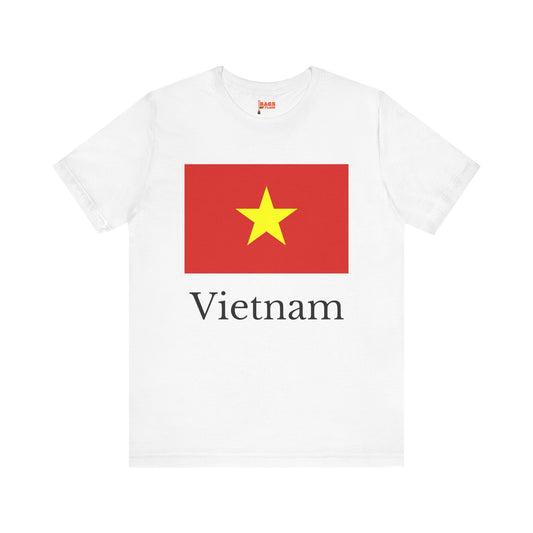-
Vietnam Flag Sweatshirt
Regular price $34.15 USDRegular priceUnit price / per -
Vietnam Inspired Sweatshirt
Regular price $34.15 USDRegular priceUnit price / per -
Vietnam Sweatshirt
Regular price $34.15 USDRegular priceUnit price / per -
Vietnam Pillow
Regular price $22.65 USDRegular priceUnit price / per -
Vietnam Backpack
Regular price $59.79 USDRegular priceUnit price / per -
Vietnam Leather Patch Hat
Regular price $18.85 USDRegular priceUnit price / per -
Vietnam Mug
Regular price $11.65 USDRegular priceUnit price / per -
Vietnam Trucker Cap
Regular price $14.90 USDRegular priceUnit price / per -
Vietnam Inspired Hoodies
Regular price $34.40 USDRegular priceUnit price / per -
Vietnam Hoodies
Regular price $34.40 USDRegular priceUnit price / per -
Vietnam T-shirts
Regular price $22.79 USDRegular priceUnit price / per -
Vietnam Flag Hoodies
Regular price $34.40 USDRegular priceUnit price / per -
Vietnam Inspired T-shirt
Regular price $22.79 USDRegular priceUnit price / per -
Vietnam Flag on T-shirt
Regular price $22.79 USDRegular priceUnit price / per -
South Vietnam and Military Academy Flags
Regular price From $43.20 USDRegular priceUnit price / per
Collection: Vietnam
The Vietnam flag symbolizes pride and unity for the Vietnamese people. Its vibrant colors and unique design hold deep historical and cultural significance. We will explore the interesting facts and proper etiquette associated with the Vietnam flag.
Overview of the Vietnam Flag's Design and Colors

The flag of Vietnam is characterized by its striking red backdrop complemented by a central yellow five-pointed star. This vibrant color palette is not only eye-catching but laden with profound significance. Red, a color often associated with revolution and struggle, vividly captures the enduring spirit and sacrifice of the Vietnamese people in their pursuit of independence. In contrast, the yellow star shining brightly against this backdrop symbolizes hope, guiding the nation toward a prosperous future. Each point of the star further symbolizes the unity among the diverse social classes within the country, from intellectuals and farmers to workers, businessmen, and soldiers, collectively striving for a common goal. This harmonious blend of colors and symbolism encapsulates the essence of the Vietnamese national identity and aspirations.
Historical Context of the Vietnam Flag
The Vietnam flag, with its distinctive red background and golden five-pointed star, was officially adopted on September 5, 1945, amidst the fervor of national liberation following World War II. This date is significant as it marks the end of French colonial dominance and the beginning of Vietnam's journey towards independence under the leadership of Ho Chi Minh. The original flag was introduced during a meaningful rally in Ba Dinh Square in Hanoi, where Ho Chi Minh read the Declaration of Independence, establishing the Democratic Republic of Vietnam.
Over the subsequent years, Vietnam experienced tumultuous periods, including conflicts and divisions between the North and South. Despite these challenges, the flag's design remained unchanged, becoming a unifying symbol for the entire country after reunification in 1976. The period following its adoption was marked by significant upheaval and transformation within the country as it navigated through decolonization, war, and reunification.
The flag's endurance throughout these periods reflects not only the resilience and unity of the Vietnamese people but also the profound changes in the country's political landscape. It is a testament to Vietnam's struggle for independence and its ongoing journey towards national unity and sovereignty. The flag, therefore, is deeply interwoven with Vietnam's modern history, symbolizing the country's aspirations and the sacrifices made to achieve them.
Symbolism Embedded in the Vietnam Flag

The flag of Vietnam stands as a powerful emblem, encapsulating the ideological foundations and aspirations of the nation. At its heart, the red backdrop is a vivid representation of the bloodshed and sacrifices made by the Vietnamese people in their struggle for independence and freedom. This deep red hue is universally recognized as a symbol of revolution and the unyielding spirit of a people united towards a common cause.
Positioned centrally on the flag, the golden five-pointed star is imbued with rich symbolism. It shines as a beacon of hope and enlightenment, guiding the nation toward progress and unity. Each point of the star reaches out to a different class of society - intellectuals, farmers, workers, businessmen, and soldiers - emphasizing the importance of harmony and collective effort for the nation's prosperity. This inclusive symbol reflects the foundational belief in the power of unity across diverse societal segments, underpinning the country's socio-political structure.
Therefore, the flag is more than a national emblem; it is a visual narrative of Vietnam's historical struggles, ideological convictions, and unwavering commitment to unity and independence. Through its simple yet profound design, the flag conveys a message of resilience, hope, and the indomitable spirit of the Vietnamese people.
Current Relevance of the Vietnam Flag
Today, the Vietnam flag holds a significant place in the hearts of its citizens and is a common sight at various state occasions, public holidays, and important cultural celebrations. Its presence during these events is a testament to the enduring spirit and unity of the Vietnamese people. Beyond its ceremonial use, the flag is also a symbol of national pride, prominently displayed in schools, government buildings, and public squares throughout the country. Despite this, it has not been without its controversies, especially among those who have differing views on Vietnam's historical and political journey. These discussions often reflect broader conversations about the nation's past, present, and future. Nevertheless, the flag continues to be an emblem of Vietnam's sovereignty and the collective identity of its people, playing a crucial role in the country's ongoing narrative.
Additional Facts and Etiquettes Related to the Vietnam Flag
Adhering to proper flag etiquette is crucial in demonstrating respect for the nation and its emblem. In Vietnam, several protocols highlight the importance of how the flag is displayed and handled, reflecting the country's deep respect for its national symbols. The flag should always be positioned in a manner that allows the red field to be seen in its full vibrant hue, ensuring the golden star is prominently centered and upright. Incorrectly hanging the flag, such as upside down or with the star misaligned, is viewed as a sign of disrespect.
It is strictly prohibited to use the Vietnam flag for commercial purposes or to incorporate its design in advertisements, signaling the need to maintain the flag's solemnity and significance. This restriction underscores the flag's role as a sacred symbol of national pride, rather than a commodity for marketing or promotion.
During ceremonial occasions, such as the playing of the national anthem or during official flag-raising events, it is customary for all present to stand in a gesture of respect. This act of standing is not merely a form of protocol but a profound display of national unity and reverence for the sacrifices and ideals the flag represents.
Furthermore, the flag serves as a poignant reminder during anniversaries and commemorative events, evoking solidarity and collective remembrance among the Vietnamese people. These practices and protocols surrounding the Vietnam flag not only honor the nation's past but also reinforce the ongoing significance of the flag as a symbol of the country's unity, sovereignty, and the shared aspirations of its people.






























